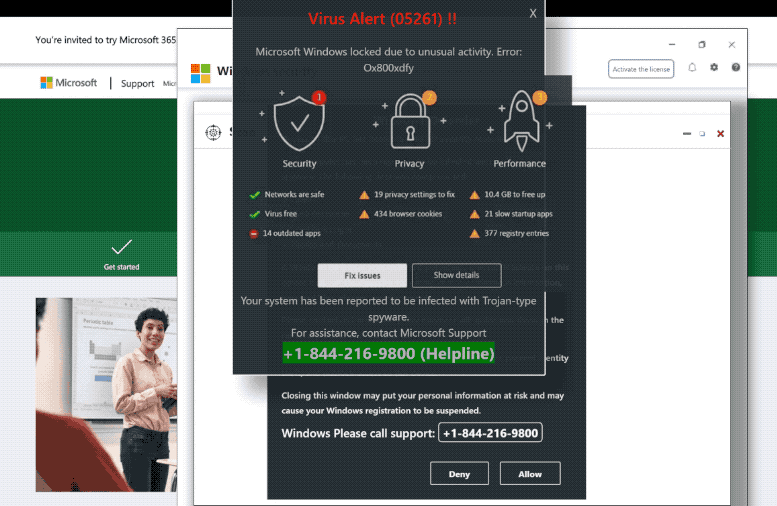The “Virus Alert (05261)” pop-up is a tech support scam that falsely claims your computer has been locked due to unusual activity. The pop-up appears when users get redirected to questionable sites and claims that users need to call the shown phone number to get assistance. Users who call the numbers may get scammed out of hundreds of dollars.
Users usually get redirected to tech support scams when they browse high-risk sites that tend to spam ads. Several sites may be showing this “Virus Alert (05261)” alert. They will all likely be made to resemble Microsoft’s official website. When users get redirected to one of these sites, they will get several pop-ups, all claiming that there’s something wrong.
Supposedly, users’ computers have been blocked because of numerous issues, like outdated apps. Furthermore, their computers have supposedly been infected with Trojan-type spyware. The alerts all display a phone number for supposed Microsoft support. One phone number we encountered is +1-844-216-9800.
These fake pop-up alerts are referred to as tech support scams because victims who call the number would be connected to professional scammers posing as Microsoft technicians. They have a specific script they always act out with users. They first ask the user to explain the issue and then offer to fix it for them. Scammers request remote access to the device to supposedly fix it. If given access, they would put on a show of removing the supposed infections and fixing other issues.
While remotely connected to users’ devices and pretending to fix them, scammers may steal files and even set passwords for the computer. When they’re finished putting on a show, scammers would demand that users pay for the supposed services they received. Usually, they demand at least a couple of hundred dollars. If users refuse to pay, scammers can become aggressive. If they set a password for the computer, they would refuse to give it to users unless they pay. Considering that users’ computers were not infected in the first place and the scammers didn’t fix anything, paying would be a waste of money.
It’s worth noting that every alert about detected viruses on a computer that appears in a browser will be a scam. Browsers are not capable of detecting infections on a computer so they will never show legitimate virus alerts. Only anti-virus programs should be trusted to show accurate information about infections on a computer.
Virus Alert (05261) !!
Microsoft Windows locked due to unusual activity. Error: 0x800xdfy
Security
Networks are safe
Virus free
14 outdated appsPrivacy
19 privacy settings to fix
434 browser cookiesPerformance
10.4 GB to free up
21 slow startup apps
377 registry entriesFix Issues Show details
Your system has been reported to be infected with Trojan-type spyware.
For assistance, contact Microsoft Support
+1-844-216-9800 (Helpline)
What triggers redirects to tech support scams
If you find that you are frequently redirected to questionable sites, it may be a sign of an adware infection. These infections are frequently unintentionally installed via the software bundling method. The infections can come attached to free software as extra offers. The offers are authorized to install automatically alongside the programs unless users manually opt out of them. However, most users are unaware of the offers because they are concealed in settings that are rarely used. Software bundling is a rather controversial installation method, and programs that use this installation method are frequently identified as potential threats by anti-virus programs.
You should be able to easily prevent unwanted installations if you pay attention when installing free programs. Installing programs using Advanced (Custom) settings rather than Default is the most important thing you need to do. If you use Default settings, as recommended by the installation window, all additional offers will be hidden and permitted to install automatically. The option to view and deselect the added offers is only available in Advanced settings. All you need to do is deselect each added offer. Do not authorize programs that use this method to install on your computer because that’s a quick way to fill your computer with junk.
It’s also recommended to install a good ablocker program. Some websites bombard users with ads and redirect them to all kinds of questionable sites. For example, sites that have pornographic or pirated content are guilty of this. A decent adblocker program can block both ads and redirects.
“Virus Alert (05261)” tech support scam removal
If you see this pop-up alert, you can just close the window. The contents of the alert are all fake, and there is no malware on your computer. However, it may be a good idea to scan your device for an adware infection because that could be why you got redirected to the tech support scam in the first place.
If you were tricked into paying the scammers, you will not be able to get your money back. If you paid via bank transfer, it may be worth contacting your bank to reverse the fraudulent transaction. However, if you paid with a gift card or via wire transfer, you won’t be able to get your money back.
Site Disclaimer
2-remove-virus.com is not sponsored, owned, affiliated, or linked to malware developers or distributors that are referenced in this article. The article does not promote or endorse any type of malware. We aim at providing useful information that will help computer users to detect and eliminate the unwanted malicious programs from their computers. This can be done manually by following the instructions presented in the article or automatically by implementing the suggested anti-malware tools.
The article is only meant to be used for educational purposes. If you follow the instructions given in the article, you agree to be contracted by the disclaimer. We do not guarantee that the artcile will present you with a solution that removes the malign threats completely. Malware changes constantly, which is why, in some cases, it may be difficult to clean the computer fully by using only the manual removal instructions.
